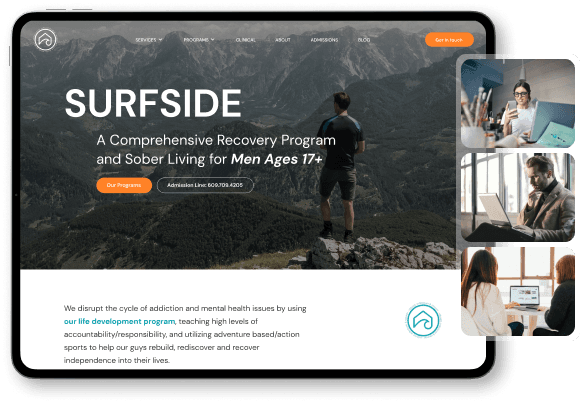blog
The Importance of Client-Centered Design for Mental Health Websites
Dec 26, 2024
In the mental health industry, creating a client-centered website isn’t just a design trend—it’s a necessity. Mental health clients often visit websites during vulnerable moments, seeking immediate support, clarity, and reassurance. A well-designed, client-centered website can make all the difference in encouraging someone to take the critical first step toward getting help.
Here’s why client-centered design is essential for mental health websites and how to implement it effectively.
What Is Client-Centered Website Design?
Client-centered design focuses on prioritizing the needs, preferences, and comfort of the user. For mental health websites, this means creating a space that is intuitive, calming, and supportive, ensuring that every visitor feels valued and cared for.
A client-centered website considers factors such as:
Ease of navigation to help clients find the information they need.
Compassionate language and visuals to foster trust and connection.
Accessibility features to ensure inclusivity for all visitors.
User-friendly tools like appointment scheduling and symptom checkers.
Why Client-Centered Design Matters for Mental Health Websites
Builds Trust and Credibility
Clients need to feel confident that they are accessing a trustworthy resource. A clean, secure, and professional website design reassures visitors that your mental health services are credible and reliable.Encourages Action
A well-structured website makes it easier for users to take actionable steps, such as filling out a contact form, scheduling an appointment, or accessing helpful resources. This can significantly increase conversions and help clients connect with the support they need.Reduces Barriers to Entry
Navigating a poorly designed website can feel overwhelming, especially for someone already dealing with anxiety or stress. A client-centered design removes barriers, ensuring that visitors can quickly find the services or information they’re looking for.Improves Accessibility
Mental health services should be available to everyone, regardless of their abilities or technological comfort level. An accessible website demonstrates inclusivity, ensuring that people with disabilities or those using assistive technologies can easily navigate your site.Creates a Positive First Impression
Your website is often the first point of contact with potential clients. A calming, client-focused design leaves a positive impression, making visitors more likely to reach out for help.
Key Elements of Client-Centered Mental Health Websites
To create a truly client-centered website, consider incorporating these design principles:
1. Intuitive Navigation
Simplify your website’s layout, using clear menus and prominent call-to-action buttons. Ensure that clients can find important pages—like "Services," "Contact Us," and "Resources"—without frustration.
2. Empathetic Visual Design
Choose calming colors, gentle imagery, and clean fonts that evoke trust and safety. Avoid cluttered layouts and overly bright visuals that can feel overwhelming.
3. Mobile-Friendly Design
With many users accessing websites on their phones, your site must be responsive and fully functional on all devices. Mobile optimization ensures a seamless experience for every visitor.
4. Accessibility Features
Incorporate accessibility standards such as:
Keyboard navigation for users with motor impairments.
Screen reader compatibility for visually impaired users.
High-contrast options and readable fonts for individuals with low vision.
5. Secure Contact and Appointment Tools
Offer user-friendly, secure forms for scheduling appointments or submitting inquiries. Include features like encrypted data transmission and automatic confirmation messages to ensure client information is protected.
6. Resourceful Content
Provide easy access to helpful resources like blog posts, self-care guides, or FAQs. This positions your website as a source of valuable information while keeping visitors engaged.
Steps to Implement Client-Centered Design
Conduct User Research
Understand the needs and preferences of your target audience. Use surveys, feedback forms, or usability tests to gain insights into what your clients value most.Collaborate with Mental Health Experts
Work closely with therapists or mental health professionals to ensure that your website’s tone and content align with the values and sensitivities of the industry.Test and Optimize
Continuously test your website’s usability and performance. Pay attention to metrics like bounce rates, session duration, and conversions to identify areas for improvement.Update Regularly
Keep your website up to date with fresh content, updated resources, and the latest design standards to ensure it remains relevant and effective.
Conclusion
A client-centered mental health website is more than just a digital presence—it’s a lifeline for those seeking support. By prioritizing the needs of your visitors through intuitive navigation, empathetic design, and accessible features, you create a space where clients feel valued, understood, and empowered to take action.
If you’re looking to design a mental health website that truly puts clients first, reach out to our team today. Let’s work together to create a space that supports your mission and makes a difference in people’s lives.
Do you find this article useful?
We create beautiful websites for mental health businesses that will help families and people in need to make the right choice. Let us help you improving your website, we got the experience and the passion to convert visitors into customers.
Get in touch and let us help you with your website
Prev
Next



